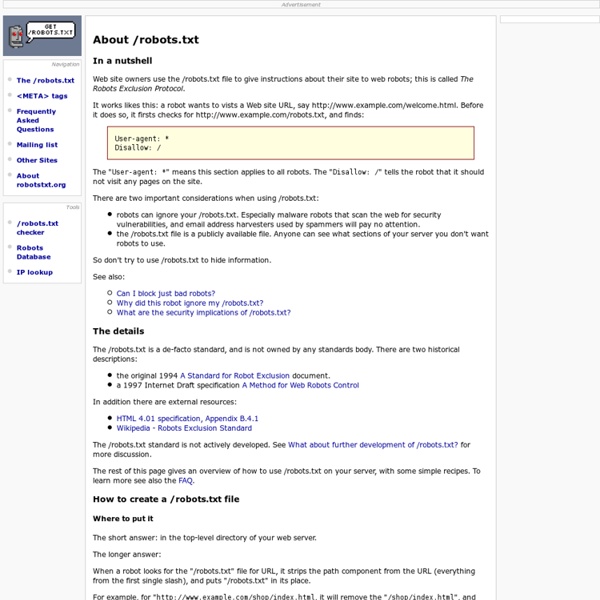The Web Robots Pages
In a nutshell Web site owners use the /robots.txt file to give instructions about their site to web robots; this is called The Robots Exclusion Protocol. It works likes this: a robot wants to vists a Web site URL, say Before it does so, it firsts checks for and finds: User-agent: * Disallow: / The "User-agent: *" means this section applies to all robots. There are two important considerations when using /robots.txt: robots can ignore your /robots.txt. So don't try to use /robots.txt to hide information. See also: The details The /robots.txt is a de-facto standard, and is not owned by any standards body. In addition there are external resources: The /robots.txt standard is not actively developed. The rest of this page gives an overview of how to use /robots.txt on your server, with some simple recipes. How to create a /robots.txt file Where to put it The short answer: in the top-level directory of your web server.
html - Can you target <br /> with css
jsoup Java HTML Parser, with best of DOM, CSS, and jquery
Initializr - Start an HTML5 Boilerplate project in 15 seconds!
Boutons graphiques en CSS - CSS Debutant
Le bouton en image qui change d'aspect au passage de la souris est très utilisé sur les pages web. Longtemps, la majorité de ces boutons graphiques étaient animés par un javascript ou pire (car plus lourd) par un applet java. Avec les CSS, par effet "rollover", la légèreté et la simplicité est de mise pour créer de beaux boutons. Fonctionne avec : tous les navigateurs graphiques Attributs utilisés : background color display float line-height margin padding text-align ; text-decoration vertical-align width Bouton CSS simple Code (x)html Un bouton étant en général utilisé pour faire un lien vers une autre page, les sélecteurs exploités dans le code CSS seront a et a:hover pour le changement d'aspect au survol du bouton (si changement souhaité bien sûr...). Pour un seul bouton, le code html peut être le suivant : <div class="bouton"><p><a href="#">Bouton</a></p></div> Prenons maintenant deux images dont l'une servira pour le bouton au repos, et l'autre pour le survol. Code CSS Plusieurs boutons CSS
HBase - Installing Apache HBase (TM) on Windows using Cygwin
Introduction Apache HBase (TM) is a distributed, column-oriented store, modeled after Google's BigTable. Apache HBase is built on top of Hadoop for its MapReduce and distributed file system implementation. All these projects are open-source and part of the Apache Software Foundation. As being distributed, large scale platforms, the Hadoop and HBase projects mainly focus on *nix environments for production installations. Purpose This document explains the intricacies of running Apache HBase on Windows using Cygwin as an all-in-one single-node installation for testing and development. Installation For running Apache HBase on Windows, 3 technologies are required: Java, Cygwin and SSH. Java HBase depends on the Java Platform, Standard Edition, 6 Release. Cygwin Cygwin is probably the oddest technology in this solution stack. To support installation, the setup.exe utility uses 2 directories on the target system. Make sure you have Administrator privileges on the target system. HBase Configuration
HTML5 Reset :: A simple set of templates for any project
scrollorama
Disclaimer: This is an experimental, just-for-fun sort of project and hasn’t been thoroughly tested. Design and build your site, dividing your content into blocks. Embed scrollorama.js after jQuery and initialize the plugin, passing the blocks class selector as a parameter. Target an element and animate its properties. The animation parameters you can use are: Hook into the onBlockChange event. scrollorama.onBlockChange(function() { alert('You just scrolled to block#'+scrollorama.blockIndex); }); Note: If you are not using the pinning feature, it is recommended you disable it.
CouchDB Java API - LightCouch
html - Create non-transparent div on top of transparent parent element
Apache HttpComponents - Apache HttpComponents
Sliding content | CSS3 transitions, transforms and animations
Often used as part of an image gallery or to show additional information, again this can be done in javascript by gradually changing the padding of elements. This often looks choppy on mobile devices, and frames can be missed if the animation is quick. CSS transitions plus transforms help out to make this a simple effect to create. Have a look at a more complete example on the demos page. Note: Animating by transitioning transforms is hardware accelerated on iOS, making this a good option there. Plan Create a container with overflow set to hidden. Demo Image 1Image 2Image 3Image 4 Code The CSS looks like this: The rather simple JS looks like this. $(document).ready(function() { $('#slide1_controls').on('click', 'span', function(){ $("#slide1_images").css("transform","translateX("+$(this).index() * -450+"px)"); $("#slide1_controls span").removeClass("selected"); $(this).addClass("selected"); });});
Related:
Related:



